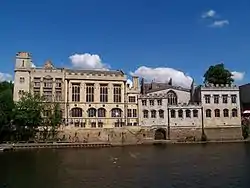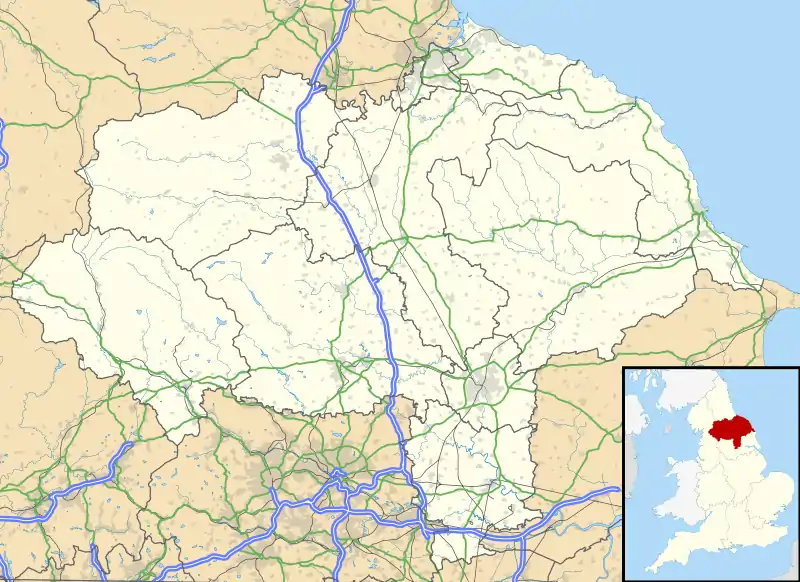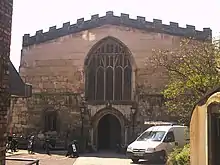York Guildhall
York Guildhall is a municipal building located behind York's Mansion House. It is a Grade I listed building.[1]
| York Guildhall | |
|---|---|
 The Guildhall facing the River Ouse | |
| Location | York, North Yorkshire |
| Coordinates | 53.95963°N 1.08563°W |
| Built | 1459 |
Listed Building – Grade I | |
| Designated | 14 June 1954 |
| Reference no. | 1257929 |
 Location of York Guildhall in North Yorkshire | |
History

The building was constructed as a meeting place for the City's guilds between 1449 and 1459.[1]
Richard III was entertained in the building in 1483[2] and the guildhall was the venue for the trial of Margaret Clitherow, a catholic martyr, in 1586.[3] it was also the place where a ransom of £200,000 was counted before being given to the Scots in payment for the release of Charles I in 1647 during the English Civil War[3] and Prince Albert, the Prince Consort to Queen Victoria was a guest of honour at a Royal banquet in the building in October 1850.[4] At the north end of the guildhall was a stained glass window painted by Henry Gyles in about 1682.[5]
In 1811 a building, designed by Peter Atkinson the younger as a council chamber, was erected to the south of the original hall (this is now known as "the Atkinson Room").[6] Then in 1891, another building, designed by Enoch Mawbey, the city surveyor, accommodating a larger council chamber, was built to the north of the original hall (this building is now known as "the Municipal Offices").[6][7] The new council chamber was decorated by Kendal, Milne and Co in the 1890s.[8]
The interior of the original building, including the stained glass window was destroyed during a Baedeker raid in 1942.[3] After the war the guildhall was rebuilt and a new stained glass window, depicting five aspects of the city's history (architecture, war, civic affairs, commercial trade and religious education), was designed and installed by Harry Harvey of York.[9] The complex was re-opened by Queen Elizabeth The Queen Mother in 1960.[10]
Throughout the 20th century meetings of the City of York Council were held in the Guildhall;[11] however, in Autumn 2017, when a programme of restoration work began at the Guildhall, temporary arrangements were put in place for the council to meet in the Citadel on Gillygate.[12]
References
- Historic England. "Guildhall and Chamber Range, Atkinson block, Common Hall Lane and boundary wall containing entrance to lane (1257929)". National Heritage List for England. Retrieved 31 August 2019.
- "Walking with King Richard III". York Press. 9 October 2013. Retrieved 31 August 2019.
- "York Guildhall". History of York. Retrieved 31 August 2019.
- McWilliams, Mark (2012). Celebration: Proceedings of the Oxford Symposium on Food and Cookery 2011. Prospect Books. ISBN 978-1903018897.
- "York Guildhall Painted Glass Window". History of York. Retrieved 12 August 2020.
- Tillott, P M (1961). "'The Guildhall, Council Chamber and Mansion House', in A History of the County of York: the City of York". London: British History Online. pp. 542–544. Retrieved 1 July 2020.
- "York Guildhall Options Appraisal" (PDF). York Council. p. 6. Retrieved 1 July 2020.
- "Municipal Offices". Heritage Gateway. Retrieved 1 July 2020.
- "Meet the man who designed the Guildhall's post-blitz stained glass window". York Press. 1 July 2019. Retrieved 1 July 2020.
- "The Guildhall". York Press. Archived from the original on 21 August 2006. Retrieved 1 July 2020.
- "The Guildhall". York Council. Archived from the original on 11 March 2015. Retrieved 12 August 2020.
- "Date set for £9m plan to transform York Guildhall into 'world-class business venue'". York Mix. 30 August 2017. Retrieved 1 July 2020.
External links
| Wikimedia Commons has media related to Guildhall, York. |